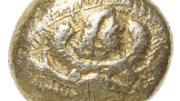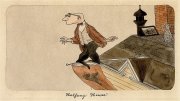The loss of the coins focused attention on their real value to Harvard. "Made of silver and bronze as well as gold, some of them rank as miniature masterpieces of classical art," Professor David Gordon Mitten had said on the day of the robbery. On the Saturday morning in May of 1979, as he gleefully examined the coins dug up on Boston's South Shore and then heaped on a table before him at the Quincy District Court, Mitten held up a thick, silver disk about the size of a half dollar, bearing the image of the nymph Arethusa in profile encircled by dolphins, and exclaimed to a newspaper reporter, "This is one of the great pieces of ancient art."
Their importance as art was reason enough--but far from the only reason--to lament the theft of Harvard's coins. Mitten catalogued their virtues: "Taken as a whole, they provide a vivid and coherent picture of the development of classical civilization throughout a thousand years. For scholars and students they are invaluable assets for teaching and research in many fields involving classical antiquity: history, economics, art history, epigraphy (the study of ancient inscriptions), sociology, mythology, religion, and metallurgy."
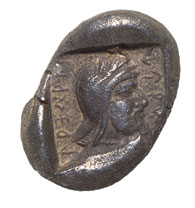
This small silver stater (literally “piece”), circa 440 B.C., was struck by a ruler in Xanthos, an important city of Lycia in southwest Asia Minor. On the reverse is the head of a bearded man with a Persian headdress, the ruler Kherei, who was nominally under Persian authority. The early Lycian rulers were among the first people to strike coins with their own portraits and thus anticipated a practice that would begin in the Greek world among the successors of Alexander the Great around 306 B.C.
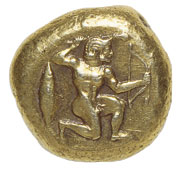
The people of Kyzikos, on the southern shore of the Sea of Marmara in what is now Turkey, changed their coin types annually, and more than 200 types are known. Always part of the image is a tuna fish, appearing on this electrum stater of 500-450 B.C. with Heracles brandishing a bow. The coins of Kyzikos were widely employed in commerce throughout the Aegean and were used for paying tribute to the Athenian empire by many of its member states.
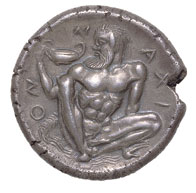
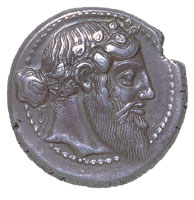
A four-drachma coin (tetradrachm), circa 460 B.C., from Naxos—not the island of Naxos in the Aegean, where Theseus dumped Ariadne on his way home from killing the Minotaur, but the city of Naxos on the coast of Sicily. It was a wine-growing city and issued coins bearing images of Dionysus, the god of wine, seen here. On the reverse is an astonishing representation of a satyr, shown with almost clinical anatomical detail. His right foot is punching out at us, his tail curls, and he braces himself against the edge of the die as he turns, perhaps for a sip of wine. A tour de force of engraving, this coin type is similar to contemporary intaglio gems in hard stone and is also related to circular pictures on the insides of wine cups produced in Athens between 510 and 490 B.C.
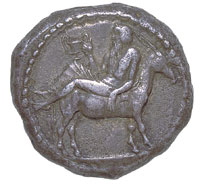
A tetradrachm of Mende, a Macedonian wine-producing city, from 450-425 B.C. The obverse representation shows Dionysus reclining on the back of a mule, a kind of vehicular couch. He hefts his particular symbol, a high, two-handled wine cup called a kantharos. This ranks as one of the finest of all early classical Greek coin types and shows that a city we know relatively little about was able to produce a coin of great sophistication. Like several others shown here, this choice coin is from the Frederick M. Watkins bequest.
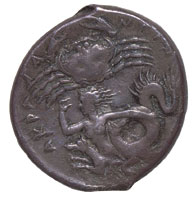
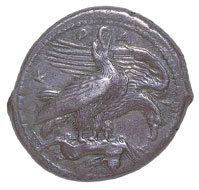
A major treasure of the Dewing collection, this extremely rare tetradrachm of the Greek city of Akragas on the southern coast of Sicily, struck about 420 B.C., shows on the obverse two magnificent eagles feasting on a hare (recalling an omen in the Agamemnon of Aeschylus), backed by a crab and the sea monster Scylla.
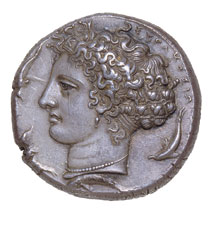
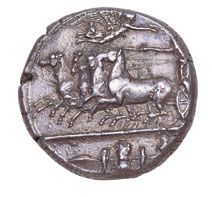
Arethusa graces some of the most prized Greek coins. A nymph favored by Artemis, she was bathing one day in the river god Alpheus’s stream when he saw her, pursued her in human form, and tried to abduct her. She fled to the isle of Ortygia, near Syracuse, where Artemis changed her into a freshwater spring. Alpheus made his way there beneath the sea and united his waters with those of the spring. This 10-drachma coin of Syracuse, from 405-400 B.C., represents Arethusa with her head surrounded by dolphins, suggesting that she is in the middle of the sea. The coin is signed on the small dolphin just under Arethusa’s neck by the master die cutter Kimon. There is also a little K on the diadem over Arethusa’s forehead. Finding the signature of the die cutter is a little like finding the “Ninas” in the cartoons of Al Hirschfeld. These decadrachms are among the largest coins ever struck by Greek cities. In the years between 420 and 390 B.C., Syracuse was under attack—first by the Athenians, then by the Carthaginians—and its ruler, Dionysius I, probably needed large coins to pay mercenary soldiers. The coins may also have served some commemorative purpose. From the Dewing collection.
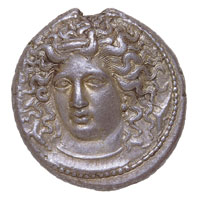
A famous tetradrachm of Syracuse, from about 410 B.C., with a frontal head of Arethusa by Kimon. Dolphins swim through her hair. Carving deeply enough into a steel die to strike such a vision is a very high artistic achievement. This front-facing head, one of the finest of all Greek coin depictions, was imitated by other mints. Reflecting the patronage of the rulers of Syracuse, who engaged the finest die cutters available and allowed them to sign their works, the coin suggests the high level of art and culture of western Greece in the period, something that could not be learned from the surviving literature or from other art, which has almost completely vanished.
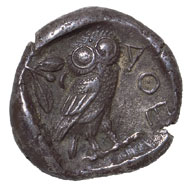
Millions of Athenian owl coins were struck during the fifth and fourth centuries B.C. and were so widely accepted that imitations in massive numbers were made in Egypt, the Near East, and the Arabian peninsula; they circulated as far east as Afghanistan. This tetradrachm was made in Athens circa 449-420 B.C. Athena—goddess of war, of peace, of wisdom, guardian of cities—is on the obverse, backed on the reverse by her owl, a sprig of olive, a crescent, and the letters alpha, theta, epsilon, identifying the coin as Athenian.
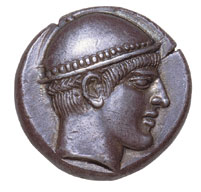
A tetradrachm of the city of Ainos in Thrace, circa 415-413 B.C., shows the head of the god Hermes wearing his traveling hat, which here looks like a beanie but is usually shown as a sort of floppy sombrero. The heads of Hermes are among the most beautiful representations in the classical style of a youthful, beardless deity. The reverse bears a male goat with an abbreviation of the city’s name.
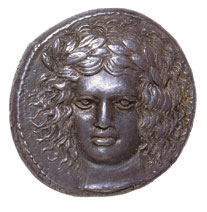
A tetradrachm of Katane, the present-day Katania in eastern Sicily, from about 410 B.C., shows a three-quarters-facing head of Apollo very similar to that of Arethusa by Kimon. The die was carved by Herakleidas, who signed it. This is one of the finest Greek coins in existence, another treasure from the Watkins bequest.
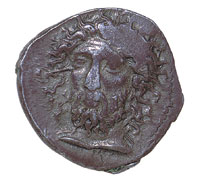
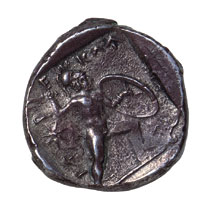
A silver stater issued in Lycia in 380-360 B.C. bears a frontal view of Päriklä, a ruler in Lycia around 370 B.C. It is one of the earliest portrait coins, and its style certainly was derived from the front-facing head of Arethusa. This coin, which on the reverse shows a striding warrior, was thought to be a fake until the mid 1950s, when a hoard of them was found.
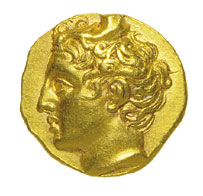
Because Actaeon had the misfortune to see Artemis bathing, she turned him into a stag, and his own dogs killed him. Here he is, growing antlers, on a gold stater from 390-330 B.C. of the city of Lampsakos, on the south shore of the Sea of Marmara very near the Dardenelles.
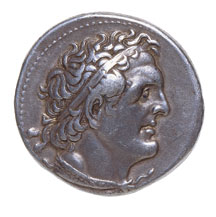
Ptolemy I of Egypt, Alexander’s successor, who founded the dynasty that culminated 300 years later in Cleopatra, was one of the first Hellenistic rulers to put his own portrait on a coin, in this case an eight-drachma piece. An eagle occupies the reverse. From the Dewing collection.
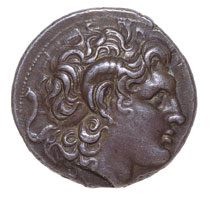

Instead of putting his own portrait on this tetradrachm from 297-281 B.C., Lysimachos, king of Thrace, chose the deified Alexander—shown wearing the ram’s horns of the Greek-Egyptian god Zeus Ammon—to demonstrate his legitimate right to rule as a successor of the great conqueror. From the Dewing collection.
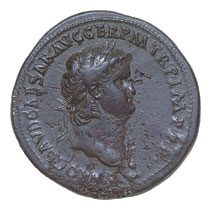
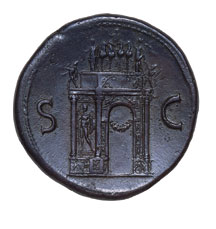
The Roman emperor Nero reintroduced the sestertius. Originally silver, it was struck in a brass-like alloy by Augustus and discontinued by Claudius. Nero’s sestertius was bronze. The large coin allowed his artists room to portray some of the services provided the people by the emperor and some of his accomplishments. This one, of A.D. 64-66, shows the well-nourished emperor on the obverse and on the reverse the Arch of Nero, a crisp depiction of a now-lost monument in Rome. Nero appears in a triumphal four-horse chariot atop the arch, escorted by Victoria and Pax. The statue of Mars in the niche associates the emperor with an earlier, famous victory by Augustus against the Parthians. The letters “SC” stand for Senatus consulto: by decree of the senate.
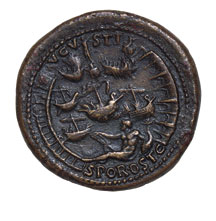
A bird’s-eye view of the port of Ostia—expanded by Claudius and for which Nero had further, ambitious development plans—appears on the reverse of this sestertius, from A.D. 64-66, with Nero on the obverse. A lighthouse at the top of the scene is surmounted by a statue of Neptune. A personification of the river Tiber reclines at bottom. The porticoes of the pier at left may represent warehouses for the city’s supply of imported grain. The slips at right may be docking areas. In the center are seven ships.
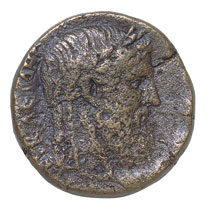
A bronze coin medallion from the city of Elis in northwestern Greece, where the Olympic Games took place every four years, probably struck as a souvenir of the games. One side carries a portrait of the Emperor Hadrian, A.D. 117-138, but the more important representation is on the obverse, the bearded head of the great gold-and-ivory, seated statue of the god Zeus made by the Athenian sculptor Phidias between 430 and 420 B.C. and installed in the Temple of Zeus at Olympia. The statue has long since vanished, and although it was one of the most influential works in classical antiquity—directly affecting the way in which the Christian God was portrayed—there are few known renderings of the original. This medallion is thus one of the rare trustworthy pieces of evidence of how Zeus’s face was represented; only about a dozen examples of this coin are known to exist.
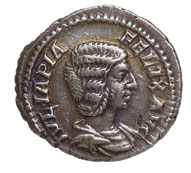
The empress Julia Domna, a priestess of the sun god at the sacred city of Emesa in present-day Syria and wife of the North African Septimius Severus, adorns this silver denarius. Their son Caracalla succeeded his father and issued this coin between A.D. 211 and 217. The fancy, lobed hairdo is typical of the Severan women. Such coin portraits, with names upon them, often enable Roman sculptured portraits in stone to be identified with some accuracy. This coin is part of a large and important group of historical Roman coins in the Harvard collection, silver denarii of the Severans, who ruled from about A.D. 190 to 235; they are an invaluable resource for study of this critical period in the development of the Roman empire.
On the following Saturday that May, police unearthed in a basement somewhere in Middlesex County the robbers' last cache of cash. Professor George M.A. Hanfmann went to the office of district attorney John Droney to examine the recovered coins. He picked from the pile and displayed to a different reporter a gold coin of Croesus--against whose wealth the wealth of others is measured--a king of Lydia, in western Asia Minor, who reigned from 561 to 547 B.C. The coin afforded Hanfmann a pedagogic opportunity to point out to the reporter and the district attorney Croesus's influence on the development of commerce.
Lumps or bars of silver and bronze had been used as money as early as the second millennium before Christ. Thus, a law might have specified that anyone killing a merchant in a dispute faced a fine of six pounds of silver. Coinage--bearing the device, stamp, or seal of a state--was invented in the seventh century B.C. Croesus was the first known ruler to issue coins in gold and silver whose purity, and therefore reliable value, were guaranteed by the government, a prerequisite to anxiety-free trade.
Some of the earliest coins were made of electrum, a naturally occurring or man-made alloy of gold and silver. Hanfmann might also have taught a lesson on metallurgy, for study of Croesus's smelting plant has explained many mysteries about how the ancients separated the gold and silver in electrum. Hanfmann for years headed the mammoth archaeological excavations at Sardis, the capital city of Lydia, and Mitten has labored there as well (see "The Search for Sardis," March-April 1998, page 51). Andrew Ramage, Ph.D. '70, a former keeper of the Coin Room and now professor of the history of art at Cornell, discovered the gold refinery when he was gently brushing a clay floor at the Sardis dig in 1968. "To stand where the wealth of Croesus was made," Hanfmann wrote that summer, "to watch his craftsmen squat at little fires, pumping at the bellows, purifying the gold in cupels, pouring it out of crucibles--this happens only in a dream. Yet this is the scene we have discovered and can prove by tiny but telling clues."
Writing about the various U.S. coins clinking in our pockets and purses relatively recently, Cornelius Vermeule '47, A.M. '51, observed, in Numismatic Art in America: Aesthetics of the United States Coinage, that "coins are the one form of art to which every American is exposed at every moment." (Vermeule catalogued some of Harvard's coins when he was an undergraduate, and, as a graduate student, he and Professor Hanfmann formed the Coin Room in 1949 to bring together in one place the large Harvard College Library coin collection and other batches of coins loaned or bequeathed to the University.) Because of their ubiquity and because most people have a fond regard for money, coins can be a splendid way to spread official messages about national identity and aspirations. In the ancient world, they were the mass medium for the purpose--wide-ranging, valued, and durable propaganda vehicles.
The early Greeks put a curious, unfocused expression on the faces of some of their coins that makes these heads appear to be relishing some secret joke. David Fromkin, professor of international relations, history, and law at Boston University, writes in The Way of the World: From the Dawn of Civilizations to the Eve of the Twenty-first Century that the so-called "archaic smile" "could stand for the Greek-speaking world as a whole in 500 B.C.: perhaps the first civilization to know the full enjoyment of happiness."
The Greeks conceived that it was a right of free and independent states to strike coins, and their multitudinous city-states did so in rich variety as a matter of civic pride. These coins are decorated chiefly with designs that refer to some "special activity or product of the city --like the sea-turtle of Aegina and the olive of Athens," wrote Hanfmann and Miriam S. Balmuth, Ph.D. '64, another former keeper of the Coin Room and today a professor of classical archaeology at Tufts, in a slim picture book called Ancient Coins. The Greeks clung "to gods, goddesses, and their legends--like the Aphrodite of Cnidus, the flying boar of Clazomenae, and the Pegasus of Corinth. Not infrequently, the name of the city was alluded to in punning or 'canting' emblems--as in the rose of Rhodes."
An example of this punning may be seen on certain coins struck by the Carthaginians (a Phoenician people) occupying the western part of Sicily in the fourth century B.C. Although they were often at war with Greeks, they wanted their coins to be accepted by the Greeks of Sicily. So they put on the obverse, or front, of the coins the head of Arethusa, an image familiar to Greeks, and on the reverse a horse's head, which related to a legend about the founding of Carthage. Behind the horse was a palm tree. The palm was a punning device designed to make the issuer of the coin recognizable to Greeks: the Greek for palm tree is phoinix, which was also their name for a Phoenician. One frequent reason for striking coins in ancient times, incidentally, was to have something with which to pay mercenary soldiers. David Mitten points out that Marc Antony, for example, had a portable mint that went with him on campaigns. "Every day ancient coins are unearthed in some Mediterranean or Middle Eastern country," says Mitten, "and among the hundreds of thousands found each year are hoards that may well have been intended as the payroll for legions, buried, as was routine in those uncertain times."
The Greeks revolted against the mighty Persian empire in 499 B.C. and began an off-and-on war with it that lasted some 170 years. While Athens had espoused freedom, that great city-state eventually began to subjugate its allies. Unhappiness visited the Greeks in civil war and class war, which brutalized formerly civilized people, as Thucydides relates in The History of the Peloponnesian War. Finally Sparta defeated Athens in 404 B.C., came to grief itself a decade later, and Ionian Greece reverted to Persia.
In his double-quick history of the world, Fromkin says of this ugly period that it foreshadowed "the coming of political messiahs, of charismatic leaders promising unity and peace, of Alexanders and Caesars."
From Macedonia, a kingdom in the north of Greece, came Philip II to unify the Greeks under his leadership and to father Alexander, in 356 B.C. Philip later hired for his son the finest young tutor available, Aristotle. At the age of 20, Alexander crossed from Europe to Asia Minor to conquer the world. For 10 years he went from victory to victory, pushing as far to the east as India, building an empire. He died of a fever, of emotional collapse, and perhaps of alcoholism, in Babylon at the age of 32.
"From the moment of Alexander's death," writes Fromkin, "the lives of those he left behind--family, friends, comrades in arms--came apart in a welter of plots, poisonings, assassinations, betrayals, and civil wars." His successors often struck his profile on their coins to associate themselves with the great man, and sometimes they showed him as deified (see page 53). Typically, theirs was an idealized Alexander, with tousled hair and upward gaze, as though regarding Mount Olympus or the heavens beyond. "Coinage in the name of Alexander became so well established," writes the Oxford numismatist Christopher Howgego in his Ancient History from Coins, "that it continued to be produced by kings and cities for up to 250 years. The majority of the four thousand varieties were in fact posthumous. Coinage struck in the name of Alexander had the advantages not only of being recognizable and widely accepted, but also of being politically neutral in the shifting sands of Hellenistic hegemony."
Alexander never put his image on a coin, so far as is known. Ptolemy I, one of his generals and his successor in Egypt--who wrote a history of the conqueror and founded the Widener Library of antiquity at Alexandria--was one of the first Hellenistic rulers to put a portrait of himself on a coin, thus beginning a tradition of presumably quite realistic coin portraiture. One may note, for instance, a strong family resemblance among the Ptolemaic rulers (Ptolemy II followed pharaonic practice and married his sister), or learn that the last king of Macedonia, Perseus (circa 212 to 168 B.C.), had a weak profile and a ratty beard. "The Hellenistic kings," write Hanfmann and Balmuth, put "their own portraits on coins, while the reverses displayed the major Hellenic deities--Zeus, Apollo, and Athena, presumably to stress personal loyalty to the ruler and to extol Hellenic culture, which served to unify the heterogeneous races of Europe, Africa, and Asia over whom these monarchs held sway."
"The Images of Alexander the Great" is a Core curriculum course that Mitten taught to 168 students last fall. He uses sculpture, coins, and paintings to illuminate Alexander's personality and career and the development of his legend. He and his students pay special attention to the importance of political imagery and how the images of Alexander reflect changing ideas of rulership. This spring he's teaching a classical archaeology course that explores "Coinage, Politics, and Economy in the Greek World" until the consolidation of Roman rule in the eastern Mediterranean. He and his three students sit at a table and pass around coins from the collection. There aren't many places where a student can have an experience like that.
Just as things were settling down in the Hellenistic kingdoms, the Romans began seriously to assert themselves. After mastering Italy, they destroyed Carthage, an undertaking that had once been on Alexander's agenda, and thereafter conquered all the countries bordering the Mediterranean, the better part of western Europe, and pieces of the British Isles. "What fascinates numismatists and historians alike," notes Lawrence University classicist Daniel J. Taylor, "is that Rome's history is indelibly stamped on its coins."
Hellenistic portraits on coins--both ideal images of the divine ruler and warts-and-all realism--provided the traditions that in time shaped the ruler coins of the late Roman republic and the empire. Augustus, the first emperor (63 B.C. to A.D. 14), opted for an idealized, eternally youthful image, but Nero portrayed himself in fleshy, unfortunate detail. The veristic style prevailed. We are informed by realistic portraits not only of emperors, but of members of their families, on coins that were issued with such frequency, and sculpted with such detail, that one can watch the children as they grow, or follow fickle fashion as empresses change their hair styles.
Richard J. Tarrant, Pope professor of the Latin language and literature, who teaches a Core course on "The Rome of Augustus," devoted much of his early lectures this term to discussions of Roman history as depicted on the coins of the era. For the first section meeting, students were asked to analyze three coins in light of a checklist of 17 elements. One coin was a didrachm of 269-266 B.C., showing a head of Hercules wearing a lion's skin, and Romulus and Remus with a wolf on the reverse. The two others, issued in 66 B.C., bore the head of Apollo, wearing a laurel wreath on one and a diadem on the other, and carried certain inscriptions. Students had to analyze in writing a gold aureus with the head of Augustus on the obverse and, on the reverse, the Temple of the Divine Julius in the Roman Forum, a reference to Augustus's adoptive father, Julius Caesar. Tarrant wanted students to pay close attention to the shift in subject matter from a mythological hero to a crowned god and then to an emperor. The first reading assignment was The Power of Images in the Age of Augustus, by German archaeologist Paul Zanker, who goes on at some length about the iconography of coins. Tarrant directed students to an on-line glossary of numismatic terms and told them of a couple of good websites about coins, should their curiosity have been aroused: www.iei.net/~tryan/coins.htm for Roman coins of the early empire and www.math.montana.edu/~umsfwest-/numis/index.html for frequently asked questions about collecting ancient coins.
Mitten rattles off the names of some other faculty members mindful of ancient Greek or Roman coins: Rabun Taylor, assistant professor of history of art and architecture, who teaches about Roman arts; Eric W. Robinson, assistant professor of the classics and of history, who teaches about Thucydides and the fall of the Roman republic; and Nino Luraghi, assistant professor of the classics, who teaches about Herodotus, Livy, and ancient Greek tyranny. Luraghi takes his students to visit the Coin Room, explains that Greek coins were understood to be political symbols, and shows what happens to the look of a city's coins when a tyrant conquers the city. The name of the city remains on the coins, but the "type," the main design on each face of a coin, changes to the type of the conqueror's coins, and thus it is possible by studying coins to track political expansions.
Why should a university want ancient coins? Daniel Taylor answers succinctly: "History is not merely recorded, it is also minted."
The coins reproduced here were chosen by Professor David Gordon Mitten, and the captions are his comments about them. He was assisted by the current keeper of the Coin Room, Florent Heintz, Ph.D. ’99, who is also a curatorial assistant at the Worcester Art Museum, working on an upcoming exhibition about the ancient city of Antioch. Michael Nedzweski, of the University Art Museums, photographed the coins. He testified about his earlier photographing of coins at the trial of the fence in Montreal. The coins from the Arthur S. Dewing Collection are reproduced with the permission of the Dewing Greek Numismatic Foundation.
Coins courtesy of the Arthur M. Sackler Museum, Harvard University Art Museums, © President and Fellows of Harvard College.
